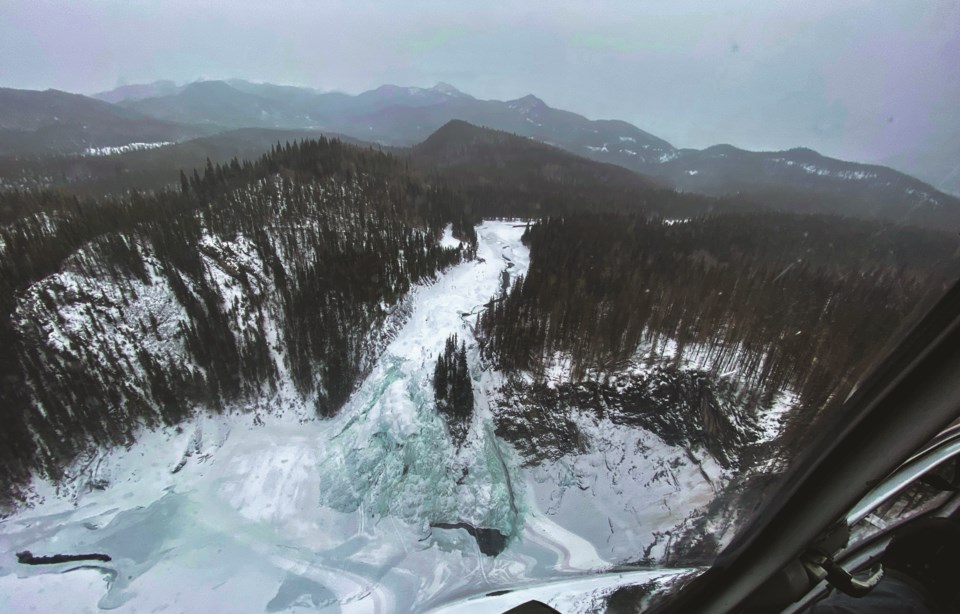It’s cold out, –29˚C to be exact, and we’re going snowmobiling.
Fortunately, in the few hours it takes to get ready and drive to our end-of-the-road launch, the temperature meliorates somewhat. Besides, with heated handles, windshield, and dressed like the Michelin Man in everything I own, plus a set of snowmobile leathers supplied by Randy Gulick, proprietor of Wild River Adventures, cold isn’t the thing that has me worried. Instead, it’s swirling gusts in the 80 kilometre/hour range, sweeping the icy mountain logging road we’re following, pushing the sleds sideways and throwing up the occasional snow witch. Twenty kilometres in, the road dives into calmer forest. Another 10 and we’ve arrived at our destination. Parking the sleds, I waddle the half-kilometre to Kinuseo Falls, a spectacular cascade higher than Niagara located some 60 km outside Tumbler Ridge, B.C. I’ve been here in the summer and seen only a couple of other visitors; today it’s devoid of anything but howling wind and snapping branches. There isn’t even the roar of the falls, which, with the exception of one miserable rivulet, are frozen into a series of giant gelid steps.
We gaze down from the platform built by BC Parks back in 1991 (they’d never do anything this cool today), scanning the gravel bar in the Murray River, where Randy uses his jet-boat to hold everything from barbecues to weddings in the summer. The straight-on view from below is money, but not really feasible in winter. But a trail up a nearby ridge lets you look down on the falls, so we head up, following the tracks of elk who’ve made it a winter yarding area. The view of the cataract from another angle is worthy. For a second, I think how crazy it is that such an enormity of water can be frozen into silence; then I realize I can’t feel my toes and it all makes sense.
We’re in Monkman Provincial Park, and, as Randy’s other summer job happens to be park maintenance guy, we head to a set of cabins at park headquarters to light the woodstove and sip hot chocolate while he readies another cabin for a group of overnighting snowmobilers expected to materialize from the frigid ether. Somehow, between chores, Randy manages to grill thinly-sliced beef tenderloin for delightful sandwiches with all the trimmings, including homemade pickles. Man, I think, I’d follow this guy anywhere. Turns out I have to.
On the way out, following Randy’s lead, myself and two companions drive much faster in the rapidly failing light. The snow witches have increased to de facto snow-nados—at one point I watch as Randy drives right through one, his sled rocked from side to side as if being pried from the trail. Thus went our first day of a deep-winter trip to one of the province’s most unheralded destinations, a metallurgical-coal-cum-fossil-trove known for its mountains, waterfalls and Tumbler Ridge UNESCO Global Geopark.
A flotilla of hopeful roofs adrift in a sea of skeptical pine some 400 km northeast of Prince George, and a few-hours from the Alberta border, Tumbler Ridge’s birth mother, the Northeast Coal Project, was the largest single industrial enterprise in British Columbia history: the entire model community, railway spur and two mines (the Quintette and Bullmoose) were erected in three years, beginning in 1981. Despite decades of ups and downs due to coal prices, Tumbler still resembles a shiny toy village, its history embodied in an enormous coal bucket dropped in the centre of town, as if from space. But it’s the whimsy of the paintings on structures throughout town that point the way to a different potential fortune: dinosaurs.
Tumbler lumbered onto the paleontological radar in 2000, when strange impressions were discovered along Flatbed Creek by eight-year-old Daniel Helm, son of a local doctor. As later confirmed by paleontologists, these were dinosaur footprints—the trackway of a heavily armoured ankylosaur—sparking considerable interest. Spearheaded through a hiking club led by the enthusiastic Helm family, residents systematically explored the area. Additional trackways were found by both amateurs and interested scientists. Then dinosaur bone turned up—the first formally identified in the province. Major finds continued to accrue and do so to this day, covering 730 million years of Earth history. All of this can be explored at the thoroughly excellent Tumbler Ridge Museum, the best such institution north of Victoria, in which we spend several rewarding hours.
Every year there’s new finds and new places to rave about. One of those is Babcock Creek, which we visit the next day with Dee and JoJo of JADEfit, adventure guides who lead us on a seven-km ski that alternates between the creek’s iced surface and its snowed-over sandbars. We reach the Babcock Seeps, well-formed curtains of knobby candles built by freeze-thaw cycles dyed with colour from the soil and friable rock layers. Walking behind them, I see the ice analogs of stalagmites and stalactites; frozen water is a theme hereabouts it seems—afternoon included.
At the local airport, JADEfit lays out a great lunch of butter chicken with rice and naan, before we embark on a heli-tour with local company Ridge Rotors. The wind is stiff in the face of an advancing front, but not as bad as the previous day. Our pilot Jotham spends an hour expertly showing us rivers, lakes, mountains, snow-ghost forests and numerous waterfalls. But perhaps the best moment was how the tour started: following the Murray River, we swooped up to the bottom of Kinuseo Falls where we got that million-dollar front-on view after all.
Leslie Anthony is a Whistler-based author, editor, biologist and bon vivant who has never met a mountain he didn't like.




